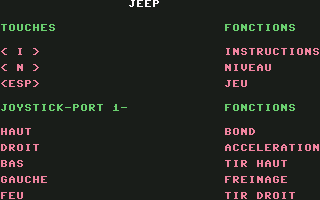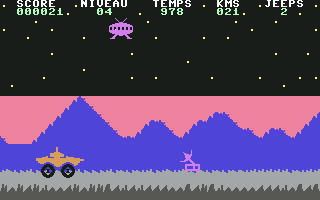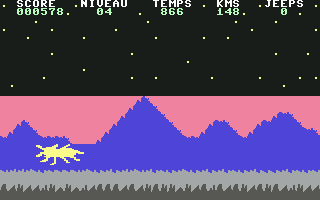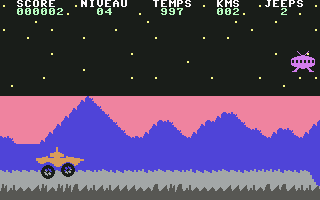Retro Replay Review
Gameplay
Jeep offers a fast-paced, arcade-style experience that keeps you constantly on your toes. As the pilot of a lunar jeep, you must traverse 900 kilometers of treacherous terrain, balancing speed and precision to evade crevices and leap over massive boulders. With only 999 units of time on the clock, the game encourages you to push the accelerator to its limits while maintaining enough control to avoid fatal collisions.
The controls are refreshingly straightforward: you accelerate, decelerate, jump, and fire in both horizontal and vertical planes. This simple input scheme belies a surprisingly deep layer of strategy. Timing your jumps over fractured ground and incoming obstacles is critical, and learning the nuances of your jeep’s handling can mean the difference between a record-setting run and an early explosion.
Adding to the challenge, two distinct types of UFOs hover into the fray. Purple saucers rain down bombs in a predictable arc, demanding evasive maneuvers on the ground below. Green UFOs, however, are sinister in their approach—dropping mines that detonate on the slightest contact. You’ll find yourself juggling target prioritization and split-second decisions as you clear rocks to keep momentum without succumbing to enemy fire.
Beyond the core patrol mode, multiple difficulty levels cater to both newcomers and arcade veterans. Casual players can get accustomed to the physics on an easier setting, while high–score chasers will gravitate toward the most punishing tiers. Every successful jump and every destroyed obstacle adds to your cumulative score, which is immortalized in the Hi-Scores table—an irresistible lure for completionists and speedrunners alike.
Graphics
Visually, Jeep channels the spirit of early ’80s arcade titles with a crisp 2D side-scrolling presentation. The lunar surface is rendered in a palette of muted grays and silvers, punctuated by the vibrant purples and greens of the UFO attackers. This restrained color scheme keeps the focus on gameplay, ensuring that obstacles and enemy projectiles never get lost in visual clutter.
Despite its retro aesthetic, the game boasts smooth animations that bring every jump and explosion to life. The jeep’s suspension bounces convincingly upon landing, and the dust clouds kicked up by acceleration add a tactile sense of weight to your vehicle. Enemy ships swoop and hover with fluid motions, making their attack patterns both readable and visually engaging.
The background scrolls at a steady pace, creating a palpable sense of forward momentum. You can almost feel the lunar dust settling behind you as craters and rock formations whip by. Occasional variations in the terrain—such as denser rock fields or wider crevices—are signaled by subtle shifts in the background art, giving you a visual cue to prepare for the next hazard.
User interface elements are kept to a minimum: a timer and score counter, both styled to evoke classic arcade cabinets. This design choice maintains immersion, letting you focus on perfecting your run rather than parsing a cluttered HUD. The end result is a presentation that feels both nostalgic and sharply responsive.
Story
While Jeep is firmly rooted in arcade action, it wraps its gameplay in the simple premise of a lunar patrol mission. You are the last line of defense on a newly colonized moon, tasked with ridding the surface of dangerous debris left behind by intense meteor showers and experimental mining operations. In this context, every jump and shot becomes a small but meaningful contribution to the survival of your outpost.
Intermittent flavor text between levels hints at escalating threats: unauthorized UFO incursions, destabilized lunar modules, and the looming possibility of a full-scale environmental collapse. Though sparse, these narrative touches provide a sense of urgency beyond mere point-gathering, motivating you to clear obstacles not just for personal glory but for the safety of your fellow colonists.
The minimal storytelling approach works to Jeep’s advantage, avoiding long cutscenes or complex backstories that might disrupt the arcade flow. Instead, it leans on environmental storytelling—ragged craters, broken equipment, and abandoned supply crates—to suggest a broader conflict. This choice keeps the focus on nonstop action while still giving your mission a compelling backdrop.
For players who crave more lore, the Hi-Scores table occasionally sprinkles in cryptic messages from commanders and rival pilots. These bite-sized snippets create a playful rivalry and hint at hidden challenges, laying the groundwork for potential future updates or spin-off titles. Even if you never pause to read them, they add a dash of character to an otherwise straightforward arcade romp.
Overall Experience
Jeep delivers an exhilarating arcade package that balances high-speed thrills with tight, responsive controls. Time pressure, combined with a steady stream of obstacles and enemy UFOs, ensures that every playthrough feels fresh and demanding. If you relish the pursuit of perfect runs and toppling high scores, this game has the addictive qualities you’re looking for.
Replayability is a major strength. The variety of terrain patterns, coupled with the unpredictability of UFO attacks, means you’ll rarely encounter the same sequence twice. Each difficulty level introduces new obstacle densities and faster enemy behaviors, offering a clear progression for players eager to test their skills.
The retro presentation is more than just eye candy—it’s an integral part of the experience, evoking classic arcade cabinets while delivering modern gameplay smoothness. Whether you’re playing on a desktop or using a gamepad, the controls feel intuitive and satisfying. Moments of near-miss jumps or perfectly timed bomb blasts create that familiar “one more try” hook that defined gaming’s golden age.
In sum, Jeep is a polished homage to arcade classics, offering a concise yet deeply engaging challenge. Its minimal story, evocative graphics, and finely tuned gameplay loop make it an ideal pick for fans of high-score chases and lunar escapades alike. For anyone seeking a lean, action-packed experience that rewards skill and perseverance, this patrol across the moon’s surface is a journey well worth taking.
 Retro Replay Retro Replay gaming reviews, news, emulation, geek stuff and more!
Retro Replay Retro Replay gaming reviews, news, emulation, geek stuff and more!








Reviews
There are no reviews yet.